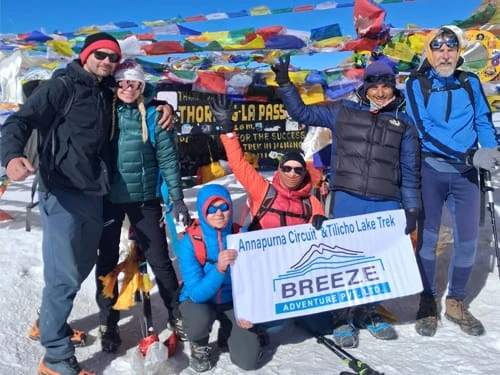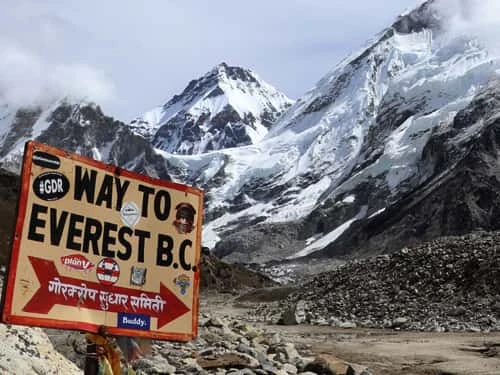Who is Hillary Step named after?
Hillary Step is named after Sir Edmund Hillary. He, along with Tenzing Norgay Sherpa, summited Everest on 29 May 1953. They did it, surviving the highest altitude and challenging paths. They were the first to summit the highest peak and make history on the Mount Everest expedition.
Before them, many British mountaineers tried to summit from the Tibet side. But they failed to reach the top of the mountain. The attempts were being done since the 1920s, with many incomplete stories of victory. Some of the expeditions used to finish at Everest Base Camp due to the lack of preparation and bad weather conditions.
In 1953, the first ever victory was achieved by Edmund Hillary and Tenzing. So, to honor the bravery and boldness of Mr. Hillary, the rocky point on Everest is given the name Hillary Step. This is a section just below the Everest summit. Many climbers have revealed that this is a significant part at an elevation of 8790 meters with much difficulty.
Why Hillary Step?
Many people ask why Hillary Step is a major point on Everest. Well, this is a significant point for several reasons. Have a look:
- A Defining Obstacle: For many decades, Hillary Step remained the ultimate test for Everest climbers. It remained a final hurdle before summiting the highest peak.
- Symbol of Everest Challenge: The Hillary Step on Everest is a symbol of the Everest challenge. This made the Everest climb even more challenging and a daredevil task.
- Cultural Significance: This has become a cultural significance in history. Every story, documentary, and movies cover Hillary Step as a major part of the climbing.
- Specific Geological Formation: This step was formed with a resistant limestone band. It is a unique geological feature that adds to its significance and notoriety.
- Bottlenecked Route: The Hillary Step was also known to form a bottleneck during the climbing season. The parties used to be on queue to negotiate the section. Due to both challenges and historical symbols, people often talk about Hillary Step when they discuss the Mount Everest expedition in Nepal.
How long is Hillary Step?
Hillary Step Mount Everest is 12 meters long, that is 39 feet from sea level. It is a vertical rock face that has remained a major obstacle for climbers. This rocky step is located between the South Summit and the actual summit of Mount Everest.
Being a long step at 8790 meters altitude is a challenge in itself, and the extreme weather adds more thrill to it. You may also ask how long it takes to climb the Hillary Step. Well, it takes around 30 minutes to complete this step. Safety measures and good preparations are necessary to climb this point (Hillary Step on Everest).
How hard is the Hillary Step?
The Hillary Step on Everest is a very hard and challenging section of the summit journey. It is a dangerous section that is generally considered the most technical part when you climb from the Nepal side.
You may not know, Hillary Step is a narrow, steep rock face requiring technical climbing under lower oxygen. There are narrow paths, a risk of deadly falls, and traffic jams on rope-fixed paths can increase more chances of deaths. Hillary Step deaths are still a huge curiosity for climbers.
So, despite the fact that the Everest trip is a fun journey, it is absolutely a life bet in some sections like Hillary Step. You have to be very careful and technically aware while climbing this part.
Where is Hillary Step located on Everest?
The Hillary Step is located on the Southeast Ridge of Mount Everest. It is just between the South Summit and the true summit. It is a rocky outcrop that is located at an elevation of more than 28 thousand feet. It is a challenging and exposed section, which is characterized by its steep angle. Also, the low oxygen levels at high altitude make it a tough thing to do.
Why is the Hillary Step so dangerous?
Hillary Step is considered extremely dangerous for the following reasons:
Steep Vertical Rock Face: The step is nearly a 12-meter (40-foot) high vertical rock wall located just near the summit of Everest. This requires climbers to ascend or descend using ropes on an exposed ridge.
Extreme Altitude: The altitude is obviously extreme, being a very close section of the highest peak in the world. It is about 8790 meters deep in the Death Zone. Here, oxygen is severely low, hampering both decision-making and physical strength.
Traffic Jams: There will be traffic jams at the peak season, but only one person can go through the rope at a time. Long queues often cause a form, forcing climbers to wait in a dangerous situation. They have to keep their patience in such a low-oxygen zone.
Extreme Temperature: There will be -19 degrees Celsius temperature on the Hillary Step, while less than that on the top of Everest. The temperature further drops to -36 degrees Celsius in January. This is a challenging temperature for survival. The cold can make you freeze, hampering further movement.
Weather Risk: The most challenging thing on Hillary Step, along with the whole summit, is the change in weather. Anytime, you will face strong winds distracting from smooth climbing.
Exhaustion and Time Pressure: There will be a moment and a rush with climbers already tired and chasing the time. Even at such high altitude and extreme cold, they tend to complete the journey and return on time. This can risk your life too.
What happened to Hillary's step on Everest
Hillary Step on Everest is believed to have collapsed in the 2015 Earthquake. Yes, you heard that right. The challenging rock face is no more in its original form. Experts believe that it has lost most of its mass.
After the devastating 2015 earthquake in Nepal, people were investigating the changed structure of the Hillary Step. Much research, investigation, and numerous photographs were done to confirm this. The Hillary Step images helped solve the issue.
In 2017, British Mountaineer confirmed its collapse. The photos of the Hillary Step before and after the earthquake were observed so closely that and finally came to this conclusion. The Hillary Step collapse is a historical moment on Everest.
What is the impact on climbing?
You might be thinking, what is the impact on climbing due to the collapse of the Hillary Step? Well, the collapse of the most technical part of the summit has made climbing easier. But this ease is not the final conclusion. The removal of this part is also believed to increase bottlenecks.
It is also believed to increase congestion at that point. The area is now a snow slope, which can make it more dangerous to navigate.
Who died on Hillary Step?
In 1997, a climber named Bruce Herrod was found dead on Hillary Step. His body was hanging from a rope at the base of the step. Mountaineer Anatoli Boukreev found his body. Boukreev was the survivor of the 1996 Everest Disaster who also rescued other climbers at that time.
It was such a horrifying moment, which took place just two weeks after the 1996 disaster on Everest. Actually, he died on his descent from the summit. He was only 37 at that time.
Recently, an Indian climber named Subratra Gosh and a Filipino climber, Phillip PJ Santiago II, died in May 2025. Both of them reportedly died while descending from the summit.
Hillary Step Everest before and after
Hillary Step was the most challenging and technical part of the Everest Summit. Located just below the summit, it had bottlenecks where climbers had to wait for their turn due to a narrow and steep section.
It was a 40-foot-long vertical section that climbers had to navigate. Also, the part remained a deadly zone, especially at descending time.
However, the earthquake in 2015 changed the structure. The vertical point reportedly collapsed, causing both easy and challenging ways forward. A big challenge of 40 feet was reduced, but climbing became too difficult with a steeper path.
How to climb the Hillary step: Necessary Tips
Hillary Step, still present as a snow slope, is a challenging part to navigate. Previously, the climbers had to cross the long vertical ice section, while now, they have to cross the snowy slope. Here are the necessary steps, you may find helpful:
- These days, you can climb this section using fixed ropes and a climbing device.
- You have to be aware of the bottlenecks due to narrow passages and resilience to fixed ropes.
- You have to manage time and conditions. Normally, the climbers were asked to descend on time to avoid extreme situations. Even a short delay can put them into a weather change.
- Keep your focus completely on your goal. Also, make sure you have enough gear, oxygen cylinders, and emergency kits.
- It is better to be mindful of Sherpa, Porters, and other climbers on the route. Coordination is a key here.
- Similarly, awareness of your surroundings is important for a smooth journey.
Well, with that, now you have a good idea about Hillary Step, its history, and present situation. With this information, you can plan a safe and satisfying journey. Being a tough section of the summit, awareness of this step can help manage the situation up there.




